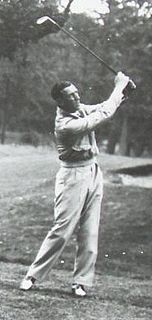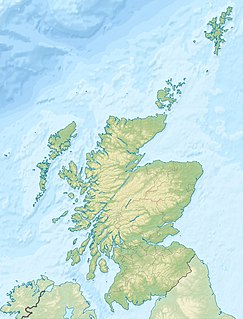
Herbert Gustavus Max Faulkner, OBE was an English professional golfer who won the Open Championship in 1951.

The Dubai Duty Free Irish Open is a professional golf tournament on the European Tour. The title sponsor is currently Dubai Duty Free.

Alfred Harry Padgham was one of the leading British professional golfers of the 1930s and 1940s. He won the 1936 Open Championship at Royal Liverpool Golf Club in Hoylake, Merseyside, England and played for Great Britain in the Ryder Cup in 1933, 1935 and 1937. He was captain of the Professional Golfers Association in 1936.
Richard Burton was an English professional golfer.

The 1934 Open Championship was the 69th Open Championship, held 27–29 June at Royal St George's Golf Club in Sandwich, England. Henry Cotton dominated the championship, leading wire-to-wire on his way to a five-stroke win and his first of three Open titles.

The 1935 Open Championship was the 70th Open Championship, played 26–28 June at Muirfield in Gullane, East Lothian, Scotland. Alf Perry won his only major title, four strokes ahead of runner-up Alf Padgham.

The 1936 Open Championship was the 71st Open Championship, held 25–27 June at Royal Liverpool Golf Club in Hoylake, England. Alf Padgham won his only major title, one stroke ahead of runner-up Jimmy Adams.

The 1938 Open Championship was the 73rd Open Championship, held 6–8 July at Royal St George's Golf Club in Sandwich, England. In terrible weather conditions that caused scores to soar, Reg Whitcombe prevailed by two strokes over runner-up Jimmy Adams to win his only major title. The purse was £500 with a winner's share of £100.

The 1939 Open Championship was the 74th Open Championship, held 5–7 July at the Old Course in St Andrews, Scotland. Dick Burton won his only major title, two strokes ahead of runner-up Johnny Bulla. The purse was £500 with a winner's share of £100. It was the last Open played for seven years, due to World War II.

The 1952 Open Championship was the 81st Open Championship, held 9–11 July at Royal Lytham & St Annes Golf Club in Lytham St Annes, England. This was the second Open at the course, its first was 26 years earlier in 1926.

The Yorkshire Evening News Tournament was an international golf tournament in the English Yorkshire area before the European Tour was founded. It was a match play tournament for most of its existence, but switched to stroke play in the 1940s. The tournament was played annually from 1923 to 1963, with no tournaments held during World War II.
The Southport Tournament was a professional golf tournament played in the Southport area in North West England. It was founded in 1930 when it was sponsored by a Manchester newspaper, the Daily Dispatch. From 1931 it was sponsored by Dunlop and was known as the Dunlop-Southport Tournament, being jointly funded by Southport Corporation. The last event was played in 1948 when Southport Corporation withdrew their funding. It was replaced by the "Dunlop Tournament", played at various location in the United Kingdom. The tournament was played in May and was played over 72 holes of stroke play. Qualifying, over 36 holes, took place at local courses immediately before the tournament.
The Roehampton Invitation Tournament was a British golf tournament played each April at the Roehampton Club from 1920 to 1935. From 1922 the tournament was played over three days. There was 36 holes of stroke play on the first day with the leading 16 players qualifying for a knock-out contest on the following two days. Except in 1920 the total prize money was £200. A challenge cup was awarded to the winner to remain the absolute property of any player who won the tournament on two occasions, not necessarily consecutive. Three players won the cup outright: Abe Mitchell, Mark Seymour and Archie Compston. The tournament was cancelled in 1936 because of "the crowded state of the fixture list".
The Dunlop-Metropolitan Tournament was an invitation professional golf tournament played in South East England. It was founded in 1934. The tournament was played towards the end of the season and was played over 72 holes of stroke play. The event had a small field; entry being mostly based on high finishes in important British and Continental events earlier in the year. Past Open Champions were also invited. The tournament was informally called "The Championship of Champions" and was "equivalent almost to the Masters' tournament of America" which was also founded in 1934.
The Daily Mail Tournament was a professional golf tournament played in the United Kingdom. The Daily Mail sponsored the St Andrews Tournament in 1919 and in 1920 continued their sponsorship with the start of the Daily Mail Tournament. The event was dropped after the 1927 tournament and not reinstated until 1936. The event was unusual in that it took place in 1940, after the start of World War II. The prize money for the 1940 event was just £500, money being raised for the Red Cross A tournament was also played in September 1945, soon after the end of the war, and was informally referred to as the "Victory" tournament. The last event was played in 1950.
The News Chronicle Tournament was a professional golf tournament played in the Brighton area. It was held from 1936 to 1951.
The PGA Assistants' Championship is a golf tournament for golf club assistant professionals. It is held by the British PGA. The first championship was held in 1930 but earlier national tournaments for assistant professionals had been held since 1910.
Walter Douglas Smithers was an English professional golfer. He tied for 8th place in the 1949 Open Championship.
Cecil Stanley Denny was an English professional golfer.
Patrick Joseph Mahon was an Irish professional golfer. He was one of the leading Irish professionals of the 1930s and had one exceptional season, 1937, where he was runner-up in three important British tournaments, third in another, finished second in the Harry Vardon Trophy standings and won the Irish Professional Championship. He won the Western Isles Open Championship in 1935 and won the Irish Professional Championship again in 1938 and 1939.






